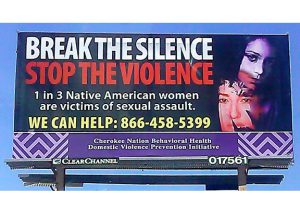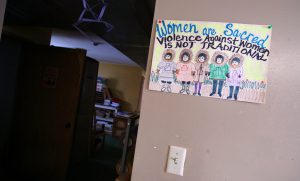The exploitation of Sarah Baartman was (at least to us now) clearly and explicitly a result of colonial, white supremacist structures in South Africa and Europe and their sexual implications at the time. I think it is important as well to consider how cases of sexual violence that are closer to home – that is, recent and in the United States – are also reflections of colonial and racial violence.
Rates of sexual violence against Native women are enormous. A study of 2000 women found 56 percent had experienced sexual violence. Native women are 2.5 times more likely to experience sexual assault than other ethnic groups (Gilpin 2016). They are also more vulnerable to organized sexual violence: a 2007 study in
Northern Minnesota found that 24% of women charged with prostitution were Native, despite representing less than 3% of the population in the area (Sullivan 2016). Native women and girls are often trafficked to areas with high concentrations of men, such as Duluth’s international sea port and rural South Dakota for pheasant season (Sullivan 2016, Hilleary 2015).

Law enforcement provides little help to sexually victimized Native women and – like in Baartman’s case – may blame them for their own trafficking or assault. Edith Chavez was abducted and drugged for several days until she managed to escape. Police did not take her statement, but rather arrested her for an unpaid ticket and “issued a press release in June claiming Chavez had smelled of alcohol and had been to a casino” (Sullivan 2016).

Blame for sexual violence among Native women must go beyond individual attackers, and take a historical, colonial, and racial perspective, especially since close to 90% of rapes reported on reservations are committed by non-Indian men (Waghorn 2015). Sexual violence is an inextricable aspect of colonialism, and the historical treatment of Native populations in America can be directly linked to the assaults so many women now face. Lisa Heth, who runs a shelter on the Crow Creek reservation, notes that girls may be vulnerable to trafficking when they come from families involved in alcohol and drugs, but it is important to understand that these kind of dependancies can be understood as a kind of violation themselves (Hilleary 2015). Says one woman living on a reservation, “we’ve already been [violated] in so many ways, from historical trauma, to the addiction, to the sexual abuse that we don’t talk about as communities, to the things that have happened at the boarding schools and the breakdown of our communities and our families” (Sullivan 2016). As one reporter points out, “it is impossible to discuss the trafficking of Native youth outside of the context of history, especially the so-called ‘boarding school’ and ‘relocation’ eras” (Hilleary 2015). Displacement, separation from families, and sexual violation are integral parts of colonialist violence that have relevance to Baartman’s life, early histories of American settlers, and the violence that pervades on reservations today.
Sources:
https://www.theguardian.com/us-news/2016/jan/19/minnesota-native-american-women-trafficking-police
http://www.voanews.com/a/sex-traffickers-targeting-native-american-women/3063457.html
http://news.sky.com/story/law-targets-abuse-of-native-american-women-10364800
Image Sources:
https://static01.nyt.com/images/2012/05/23/us/ASSAULTS-2/ASSAULTS-2-jumbo.jpg
Further reading:
http://digitalcommons.unl.edu/cgi/viewcontent.cgi?article=1013&context=humtraffconf
https://intercontinentalcry.org/colonialism-genocide-and-gender-violence-indigenous-women/
http://www.nytimes.com/2012/05/23/us/native-americans-struggle-with-high-rate-of-rape.html

In order to end trafficking among native youth, the cultural stereotypes must be addressed. It’s an extremely devastating situation, where due to a cultural profile and gender, indigenous women can be targeted and harmed. You pointed out the fact that non-indigenous men commit many of these rape cases. This is something that must be emphasized, as people are often overlooking this fact because of stereotyping that the problem lies with the indigenous groups themselves. The lack of law enforcement support in protecting this group is not only appalling but also traumatizing for friends, families and those empathic enough to understand the need for equal treatment and protection under the law for all. As unfortunate as it is, much of the needed change is in the power of law enforcement officials. They have the ability to legally pursue charges for the many assailants that are facing no consequences for their brutal actions against Native women.